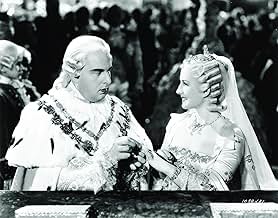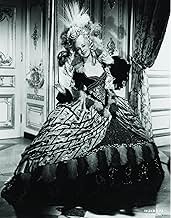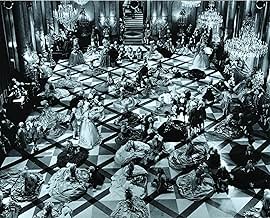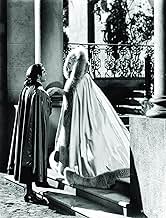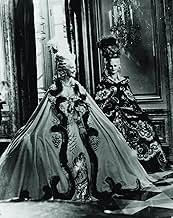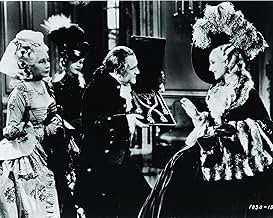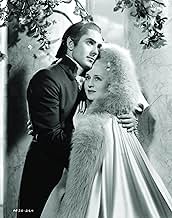IMDb रेटिंग
7.3/10
3.5 हज़ार
आपकी रेटिंग
अपनी भाषा में प्लॉट जोड़ेंThe tragic life of Marie Antoinette, who became queen of France in her late teens.The tragic life of Marie Antoinette, who became queen of France in her late teens.The tragic life of Marie Antoinette, who became queen of France in her late teens.
- 4 ऑस्कर के लिए नामांकित
- 5 जीत और कुल 5 नामांकन
Albert Dekker
- Comte de Provence
- (as Albert Van Dekker)
फ़ीचर्ड समीक्षाएं
A legend in France tells that Julien Duvivier was involved in this film;if he really did something,it was probably minimal;an educated man like him would have been scared by the numerous historical errors of the film.
Here are some of them: -Never Louis XV spoke of sending the dauphine back to where she once belonged,in Austria.The quarrel with Madame du Barry is pure fiction:M.A. spoke once to the favorite ,she said " There are many people here today in Versailles."She never addressed her afterward.
-Louis XVI was not the moron we see in the film.He was actually an educated man.When he was in jail,he would teach his son maths,history ,geography and other subjects.He was not made to be king,that's true ,and all that follows Louis XV 's death is accurate .He reportedly said to his distraught wife :"What a misfortune,we're too young to reign!".He used to go hunting (his favorite pastime) but he was not the half-wit depicted in Van Dyke's film.
-The Royal family was not imprisoned in Le Temple just after the night of Varennes.That escape took place on the 20th of June 1791.The storming of the Tuileries (not included in the movie for a good reason)happened on August ,the 10th 1792;the fall of the monarchy and the Republic followed in September the same year.
-But the queen's last night takes the biscuit!Fersen in her dungeon,no less!
Forget history,and you have a wonderful show,a novel based on M.A.'s life.There are many remarkable things all along the viewing: M.A. in the corridors of her palace,in Vienna ,where her mother tells her "You shall be queen of France" . The sentence will come back ,quite rightly so,in the last pictures.
The affair of the necklace,told in admirable succinct style;the scene when the queen learns that the cardinal de Rohan is free ,while arriving at the opera theater,is a great dramatic idea.
The longest night of June,which tragically ended in Varenne is given an adequate dark treatment where only the torches lighten the forest or the village.
The scene which climaxes the movie is the Royal family's last supper.Here Robert Morley transcends the limitation he is working under ,and makes Louis XVI a clever sensitive man :the rapport he has with his child was obvious in real life and all rings true.The broken soldier's story will intensely move you.Besides ,it was a good idea to film M.A.'s and the dauphin's separation just after the king's death (actually ,the king died on the 21th of January 1793,and M.A. was separated from her child in the following Summer) cause it increases tenfold the queen's tragedy.This scene lasted one hour!one hour! When she left LE Temple for la Conciergerie (where you can visit her dungeon today),the queen said:"Nothing can hurt me now."
Here are some of them: -Never Louis XV spoke of sending the dauphine back to where she once belonged,in Austria.The quarrel with Madame du Barry is pure fiction:M.A. spoke once to the favorite ,she said " There are many people here today in Versailles."She never addressed her afterward.
-Louis XVI was not the moron we see in the film.He was actually an educated man.When he was in jail,he would teach his son maths,history ,geography and other subjects.He was not made to be king,that's true ,and all that follows Louis XV 's death is accurate .He reportedly said to his distraught wife :"What a misfortune,we're too young to reign!".He used to go hunting (his favorite pastime) but he was not the half-wit depicted in Van Dyke's film.
-The Royal family was not imprisoned in Le Temple just after the night of Varennes.That escape took place on the 20th of June 1791.The storming of the Tuileries (not included in the movie for a good reason)happened on August ,the 10th 1792;the fall of the monarchy and the Republic followed in September the same year.
-But the queen's last night takes the biscuit!Fersen in her dungeon,no less!
Forget history,and you have a wonderful show,a novel based on M.A.'s life.There are many remarkable things all along the viewing: M.A. in the corridors of her palace,in Vienna ,where her mother tells her "You shall be queen of France" . The sentence will come back ,quite rightly so,in the last pictures.
The affair of the necklace,told in admirable succinct style;the scene when the queen learns that the cardinal de Rohan is free ,while arriving at the opera theater,is a great dramatic idea.
The longest night of June,which tragically ended in Varenne is given an adequate dark treatment where only the torches lighten the forest or the village.
The scene which climaxes the movie is the Royal family's last supper.Here Robert Morley transcends the limitation he is working under ,and makes Louis XVI a clever sensitive man :the rapport he has with his child was obvious in real life and all rings true.The broken soldier's story will intensely move you.Besides ,it was a good idea to film M.A.'s and the dauphin's separation just after the king's death (actually ,the king died on the 21th of January 1793,and M.A. was separated from her child in the following Summer) cause it increases tenfold the queen's tragedy.This scene lasted one hour!one hour! When she left LE Temple for la Conciergerie (where you can visit her dungeon today),the queen said:"Nothing can hurt me now."
Made directly after Irving Thalberg's death but arranged by him beforehand this was Norma's final solo showcase. A mixture of the loss of her behind the scenes champion, poor script judgment and her vanity which caused her to turn down possible career savers Mrs. Miniver and Old Acquaintance lead to her days as a top star coming to an end. She still had a few decent pictures in her future, most notably The Women, but this is the last of her big star vehicles and her final big success as the main star of a film.
But this is certainly a grand way to end her time at the top. Norma does well in the lead her occasional lapses into grandiosity are well suited to a queen and don't get in the way of her characterization like they often did in several of her other films and her smaller moments are well played. Although this really should have been in color, the sets, wigs and costumes are almost impossibly lavish and are dazzling even in B&W. It's an enjoyable if questionably accurate historical account of Marie's rise and fall.
Aside from Shearer Robert Morley gives a gem of a performance as the not terribly bright Louis XVI, never making him seem a simpleton just a gentle man unequal to the role thrust upon him by birth. There are a few other good performances from Gladys George as the cheap but flashily dressed Madame du Barry and Joseph Schildkraut as the queen's venal cousin. Tyrone Power is impossibly handsome but his part is really window dressing so he doesn't make much of an impression.
Fine through they all are the film would be nothing without Norma. The title role requires someone whose well seasoned star power couldn't be overpowered by the sumptuous trappings and this is Norma's show straight down the line. Perhaps the one she was most suited to it's certainly one of her strongest performances. The film itself is a trifle overlong but for those who stick with it worthwhile entertainment.
But this is certainly a grand way to end her time at the top. Norma does well in the lead her occasional lapses into grandiosity are well suited to a queen and don't get in the way of her characterization like they often did in several of her other films and her smaller moments are well played. Although this really should have been in color, the sets, wigs and costumes are almost impossibly lavish and are dazzling even in B&W. It's an enjoyable if questionably accurate historical account of Marie's rise and fall.
Aside from Shearer Robert Morley gives a gem of a performance as the not terribly bright Louis XVI, never making him seem a simpleton just a gentle man unequal to the role thrust upon him by birth. There are a few other good performances from Gladys George as the cheap but flashily dressed Madame du Barry and Joseph Schildkraut as the queen's venal cousin. Tyrone Power is impossibly handsome but his part is really window dressing so he doesn't make much of an impression.
Fine through they all are the film would be nothing without Norma. The title role requires someone whose well seasoned star power couldn't be overpowered by the sumptuous trappings and this is Norma's show straight down the line. Perhaps the one she was most suited to it's certainly one of her strongest performances. The film itself is a trifle overlong but for those who stick with it worthwhile entertainment.
This film boasts a number of wonderful performances and is a great example of film acting in the thirties and the power of the studios. Robert Morley steals the show as Louis XVI, but equally fine are John Barrymore as the dying Louis XV, Gladys George as Madame du Barry, Joseph Schildkraut as the Duke of Orleans and a whole slew of wonderful character actors who enlivened even the smallest role. Norma Shearer admirably tackles the nearly impossible task of portraying the life of Marie Antoinette from a young girl to a broken woman on her way to the guillotine. In the style of the time, the film has a tendency toward histrionics but for the viewer with patience the overall effect is fascinating. Of special interest to students of art direction. The sets and costumes are incredible.
It never ceases to amaze me at how completely I might be suddenly drawn into the emotional moment of a film by the power of the actor. Usually the strongest ones come suddenly, and without warning, giving you no time to put up defenses. Brando's eruptions of moods when talking to his dead wife in Last Tango in Paris is probably the most dramatic example of this. (His greatest scene ever, that I have witnessed) But before that, Norma Shearer's panic and utter emotional breakdown when the guards come to take her son from her in the prison, is overwhelming and complete. Anyone who is not genuinely moved to the core by this incredible performance, either sleeps or does not possess those human sensitivities that are torn by the loss of a child. For it is not sympathy that is evoked, but an empathy called forth by the raw, human agony of the suffering before you. Years later when I visited the actual site in Paris where that tragedy would have taken place, I experienced a time of respect and reflection such as I have never had in any other place in the world that I have visited.
This is one of the truly great films. If you want to find out how deeply someone can feel, show it to them and observe. Norma Shearer set a standard I fear has been forgotten, as evidenced by the way tinsel town hands out awards today for mediocre work pushed onto the modern consciousness by glitzy ad campaigns and self-serving accolades.
This is one of the truly great films. If you want to find out how deeply someone can feel, show it to them and observe. Norma Shearer set a standard I fear has been forgotten, as evidenced by the way tinsel town hands out awards today for mediocre work pushed onto the modern consciousness by glitzy ad campaigns and self-serving accolades.
Here at The Rag, we've learned our lesson: No matter what, give a movie a chance. Just give a movie ten minutes, and if you still hate it as much as you thought you would, feel free to turn it off. If the movie stars an actress you despise, contains a supporting cast you don't normally like, and centers on a subject of which you have no interest, you just might find yourself riveted and impressed. What movie made us learn our lesson? Marie Antoinette, starring Norma Shearer, someone whose movies we'd previously avoided.
The first fifteen minutes of this movie are incredible. Adrian's costumes belong in a museum, as gown after gown after gown are breathtaking, and surprisingly did not bring home an Oscar for the remarkable designer. The Academy Awards didn't have an Oscar for costume design until 1948, which, when you think of all the incredible costumes present in the 1930s and 1940s, is shocking. The art direction, while awarded with a nomination, was passed over in favor of The Adventures of Robin Hood. The incredible sets laden with paintings, chandeliers, rugs, beautiful dishes, jewels, ballroom decorations, draperies, bedroom pieces, and other furniture, was passed over for a forest. When you watch this movie, you'll realize how silly that is. Another silliness is the lack of nominations for Best Picture and Best Director for W.S. Van Dyke. This is a large-scale, expensive, lush epic, and it's ridiculous to look back at Frank Capra's wins for You Can't Take It With You when Marie Antoinette wasn't even nominated.
This heavy epic chronicles Marie's time from age fourteen until her death. Norma Shearer is given an enormous amount to do, and she does it very well. She has to be giddy and young, excited for her marriage, disappointed, afraid, frivolous, betrayed, in love, a mother, and finally, destroyed. As a young girl, she gets betrothed to the soon-to-be King of France, and her wedding night with Robert Morley is an especially emotional scene. They both give excellent performances, and since I normally can't stand either, it's quite a compliment from me. Robert is simple and an introvert who doesn't want to expose himself to potential ridicule, and Norma just wants to be a good wife. When she realizes her marriage will be different than promised, she turns to material pleasures and surface relationships to make her happy.
With a supporting cast of Joseph Schildkraut as an enormously slimy villain, Gladys George as the famous du Barry, John Barrymore as an ailing king, Tyrone Power as the pretty but poorly acted love interest, and Henry Stephenson as a sympathetic ear, there are plenty of varied scenes in this long movie to keep you interested. As one of the earliest films to have an intermission, overture, and entr'acte, this takes a bit of the epic factor out of the following year's Gone With the Wind, which boasted of being the grandest epic of all time. Marie Antoinette is one of the great classics that is dramatic without being grotesque and manages to win you over even if you don't expect to be. Well done, Norma.
The first fifteen minutes of this movie are incredible. Adrian's costumes belong in a museum, as gown after gown after gown are breathtaking, and surprisingly did not bring home an Oscar for the remarkable designer. The Academy Awards didn't have an Oscar for costume design until 1948, which, when you think of all the incredible costumes present in the 1930s and 1940s, is shocking. The art direction, while awarded with a nomination, was passed over in favor of The Adventures of Robin Hood. The incredible sets laden with paintings, chandeliers, rugs, beautiful dishes, jewels, ballroom decorations, draperies, bedroom pieces, and other furniture, was passed over for a forest. When you watch this movie, you'll realize how silly that is. Another silliness is the lack of nominations for Best Picture and Best Director for W.S. Van Dyke. This is a large-scale, expensive, lush epic, and it's ridiculous to look back at Frank Capra's wins for You Can't Take It With You when Marie Antoinette wasn't even nominated.
This heavy epic chronicles Marie's time from age fourteen until her death. Norma Shearer is given an enormous amount to do, and she does it very well. She has to be giddy and young, excited for her marriage, disappointed, afraid, frivolous, betrayed, in love, a mother, and finally, destroyed. As a young girl, she gets betrothed to the soon-to-be King of France, and her wedding night with Robert Morley is an especially emotional scene. They both give excellent performances, and since I normally can't stand either, it's quite a compliment from me. Robert is simple and an introvert who doesn't want to expose himself to potential ridicule, and Norma just wants to be a good wife. When she realizes her marriage will be different than promised, she turns to material pleasures and surface relationships to make her happy.
With a supporting cast of Joseph Schildkraut as an enormously slimy villain, Gladys George as the famous du Barry, John Barrymore as an ailing king, Tyrone Power as the pretty but poorly acted love interest, and Henry Stephenson as a sympathetic ear, there are plenty of varied scenes in this long movie to keep you interested. As one of the earliest films to have an intermission, overture, and entr'acte, this takes a bit of the epic factor out of the following year's Gone With the Wind, which boasted of being the grandest epic of all time. Marie Antoinette is one of the great classics that is dramatic without being grotesque and manages to win you over even if you don't expect to be. Well done, Norma.
क्या आपको पता है
- ट्रिवियाAccording to Wikipedia, the movie had thousands of costumes and lavish set designs. Adrian visited France and Austria in 1937 researching the period. He studied the paintings of Marie Antoinette, even using a microscope on them so that the embroidery and fabric could be identical. Fabrics were specially woven and embroidered with stitches sometimes too fine to be seen with the naked eye. The attention to detail was extreme, from the framework to hair. Some gowns became extremely heavy due to the embroidery, flounces and precious stones used. Norma Shearer's gowns alone had a combined weight of over 1,768 lb., the heaviest being the wedding dress.
- गूफ़At the time of their wedding, the Dauphin, Louis, was 15 and Marie Antoinette was 14. Norma Shearer could (barely) get away with portraying a 14-year-old (as she portrayed a 13-year-old Juliet in ROMEO AND JULIET (1936) because many noble/royal females were more mature and had regal bearing), but Robert Morley looked 35, not 15.
- भाव
Marie Antoinette: I once thought if I were queen, I'd be so happy. To be applauded and adored and obeyed. I don't want it now. I just want to be free. To be with you. To love you. I cannot wear a crown upon my heart.
- इसके अलावा अन्य वर्जन"Unrestored" film has now been restored and is available on DVD. When the film played the Carthay Circle in Los Angeles and the Astor Theatre in New York as a reserved seat "road show" attraction, the print ran eleven minutes longer than the generally available 149 minute Turner Library print. These eleven minutes contained an overture, entr'acte, and exit music, with an intermission immediately following Antoinette's emotional farewell to Fersen on the steps of Versailles. These remnants of the "road show" presentation have now been restored to the new Warner Bros. Home Video DVD, which runs a little over 157 minutes.
- कनेक्शनEdited into Hollywood: The Dream Factory (1972)
टॉप पसंद
रेटिंग देने के लिए साइन-इन करें और वैयक्तिकृत सुझावों के लिए वॉचलिस्ट करें
- How long is Marie Antoinette?Alexa द्वारा संचालित
विवरण
बॉक्स ऑफ़िस
- बजट
- $29,26,000(अनुमानित)
- चलने की अवधि2 घंटे 29 मिनट
- पक्ष अनुपात
- 1.37 : 1
इस पेज में योगदान दें
किसी बदलाव का सुझाव दें या अनुपलब्ध कॉन्टेंट जोड़ें



